Assessment of Measures to Increase Water Efficiency in Public Swimming Pools
Abstract
1. Introduction
2. Materials and Methods
3. Results and Discussion
3.1. Reduction of Consumption
3.2. Reuse of the Volume of Daily Water Renewal in Swimming Pools to Flush Toilets
4. Conclusions
Author Contributions
Funding
Acknowledgments
Conflicts of Interest
References
- Ma, T.; Sun, S.; Fu, G.; Hall, J.W.; Ni, Y.; He, L.; Yi, J.; Zhao, N.; Du, Y.; Pei, T.; et al. Pollution exacerbates China’s water scarcity and its regional inequality. Nat. Commun. 2020, 11, 650. [Google Scholar] [CrossRef]
- Kundzewicz, Z.W.; Mata, L.J.; Arnell, N.W.; Döll, P.; Jimenez, B.; Miller, K.; Oki, T.; ¸Sen, Z.; Shiklomanov, I. The implications of projected climate change for freshwater resources and their management. Hydrol. Sci. J. 2008, 53, 3–10. [Google Scholar] [CrossRef]
- Chalmers, P. Climate Change. Implications for Buildings. Key Findings from the Intergovernmental Panel on Climate Change, Fifth Assessment Report; European Climate Foundation, Building Performance Institute Europe, Global Buildings Performance Network, World Business Council for Sustainable Development, University of Cambridge’s Judge Business School, Institute for Sustainability Leadership; BPIE: Brussels, Belgium, 2014. [Google Scholar]
- Spinoni, J.; Vogt, J.V.; Naumann, G.; Barbosa, P.; Dosio, A. Will drought events become more frequent and severe in Europe? Int. J. Climatol. 2018, 38, 1718–1736. [Google Scholar] [CrossRef]
- United Nations. World Urbanization Prospects; The 2014 Revision (Highlights); United Nations—Department of Economic and Social Affairs: New York, NY, USA, 2014; ISBN 978-92-1-151517-6. [Google Scholar]
- Ribeiro, J.M.P.; Bocasanta, S.L.; Ávila, B.O.; Magtoto, M.; Jonck, A.V.; Gabriel, G.M.; Guerra, J.B.S.O.D.A. The adoption of strategies for sustainable cities: A comparative study between Seattle and Florianopolis legislation for energy and water efficiency in buildings. J. Clean. Prod. 2018, 197, 366–378. [Google Scholar] [CrossRef]
- Wilk, J.; Wittgren, H. Adapting Water Management to Climate Change; Swedish Water House Policy Brief 2009, Nr. 7; SIWI: Stockholm, Sweden, 2009. [Google Scholar]
- Haines, A.; Kovats, R.; Campbell-Lendrum, D.; Corvalan, C. Climate change and human health: Impacts, vulnerability and public health. Public Health 2006, 120, 585–596. [Google Scholar] [CrossRef]
- Trenberth, K. Changes in precipitation with climate change. Clim. Res. 2011, 47, 123–138. [Google Scholar] [CrossRef]
- AWWA. Climate Change and Water Resources: A Primer for Municipal Water Providers; AWWA Research Foundation, University Corporation for Atmospheric Research, American Water Works Association; 1P-5C-91120-05/06-NH; IWA Publishing: Denver, CO, USA, 2006. [Google Scholar]
- Magadza, C. Climate change impacts and human settlements in Africa: Prospects for adaptation. Environ. Monit. Assess. 2000, 61, 193–205. [Google Scholar] [CrossRef]
- World Health Organization. Summary and Policy Implications Vision 2013: The Resilience of Water Supply and Sanitation in the Face of Climate Change; WHO—Department for International Development: Geneva, Switzerland, 2009; ISBN 978-92-4-159842-2. [Google Scholar]
- Giorgi, F.; Lionello, P. Climate change projections for the Mediterranean region. Glob. Planet. Change 2007, 63, 90–104. [Google Scholar] [CrossRef]
- Pausas, J.G. Changes in fire and climate in the Eastern Iberian Peninsula (Mediterranean Basin). Clim. Change 2004, 63, 337–350. [Google Scholar] [CrossRef]
- European Commission. COM 718 Communication from the Commission to the Council and the European Parliament on Thematic Strategy on the Urban Environment; Commission of the European Communities—SEC: Brussels, Belgium, 2006; p. 16.
- Wilby, R. A review of climate change impacts on the built environment. Built Environ. J. 2007, 33, 31–45. [Google Scholar] [CrossRef]
- La Licata, I.; Colombo, L.; Francani, V.; Alberti, L. Hydrogeological study of the glacial—Fluvio glacial territory of Grandate (Como, Italy) and stochastical modeling of groundwater rising. Appl. Sci. 2018, 8, 1456. [Google Scholar] [CrossRef]
- Dean, J.; Sholley, M. Groundwater Basin Recovery in Urban Areas and Implications for Engineering Projects. Engineering Geology for Tomorrow’s Cities; IAEG: Dublin, Ireland, 2006. [Google Scholar]
- United Nations. Buildings and Climate Change: Summary for Decision-Makers; United Nations Environment Program: Paris, France, 2009; ISBN 987-92-807-3064-7. [Google Scholar]
- UNEP. Technologies for Climate Change Mitigation: Building Sector; UNEP Risø Centre on Energy, Climate and Sustainable Development: Copenhagen, Denmark, 2012; ISBN 978-87-92706-57-7. [Google Scholar]
- Hof, A.; Schmitt, T. Urban and tourist land use patterns and water consumption: Evidence from Mallorca, Balearic Islands. Land Use Policy 2011, 28, 792–804. [Google Scholar] [CrossRef]
- Fisher-Jeffes, L.; Gertse, G.; Armitage, N. Mitigating the impact of swimming pools on domestic water demand. Water SA 2015, 41, 238–246. [Google Scholar] [CrossRef]
- Morote, Á.-F.; Saurí, D.; Hernández, M. Residential Tourism, Swimming Pools, and Water Demand in the Western Mediterranean. Prof. Geogr. 2017, 69, 1–11. [Google Scholar] [CrossRef]
- Pimentel-Rodrigues, C.; Silva-Afonso, A. Contributions of water-related building installations to urban strategies for mitigation and adaptation to the climate change. Appl. Sci. 2019, 9, 3575. [Google Scholar] [CrossRef]
- Wyczarska-Kokot, J. The Study of Possibilities for Reuse of Washings from Swimming Pool Circulation Systems. Ecol. Chem. Eng. S 2016, 23, 447–459. [Google Scholar] [CrossRef]
- Łaskawiec, E.; Dudziak, M.; Wyczarska-Kokot, J. Assessment of the possibility of recycling backwashing water from the swimming pool water treatment system. Ecol. Chem. Eng. A 2016, 23, 401–410. [Google Scholar]
- Wyczarska-Kokot, J.; Lempart, A. The reuse of washings from pool filtration plants after the use of simple purification processes. Arch. Civ. Eng. Environ. 2018, 11, 163–170. [Google Scholar] [CrossRef]
- Silva, F.; Antão-Geraldes, A.M.; Zavattieri, C.; Afonso, M.J.; Freire, F.; Albuquerque, A. Improving water efficiency in a municipal indoor swimming-pool complex: A case study. Appl. Sci. 2021, 11, 10530. [Google Scholar] [CrossRef]
- Silva-Afonso, A.; Pimentel-Rodrigues, C. Water efficiency of products. The Portuguese system of certification and labeling. J. Am. Water Works Assoc. 2010, 102, 52–56. [Google Scholar]
- Rodrigues, F.; Silva-Afonso, A.; Pinto, A.; Macedo, J.; Silva-Santos, A.; Pimentel-Rodrigues, C. Increasing water and energy efficiency in university buildings: A case study. Environ. Sci. Pollut. Res. 2019, 27, 4571–4581. [Google Scholar] [CrossRef] [PubMed]
- Silva-Afonso, A.; Pimentel-Rodrigues, C. Manual de Eficiência Hídrica em Edifícios; ANQIP: Aveiro, Portugal, 2017. (In Portuguese) [Google Scholar]
- ANQIP (Associação Nacional para a Qualidade nas Instalações Predais). Technical Specification ETA 0905:2009 (Sistemas Prediais de Reutilização e Reciclagem de Águas Cinzentas). Available online: https://anqip.pt/index.php/pt/comissoes-tecnicas/98-comissao-tecnica-0905 (accessed on 1 March 2022). (In Portuguese).
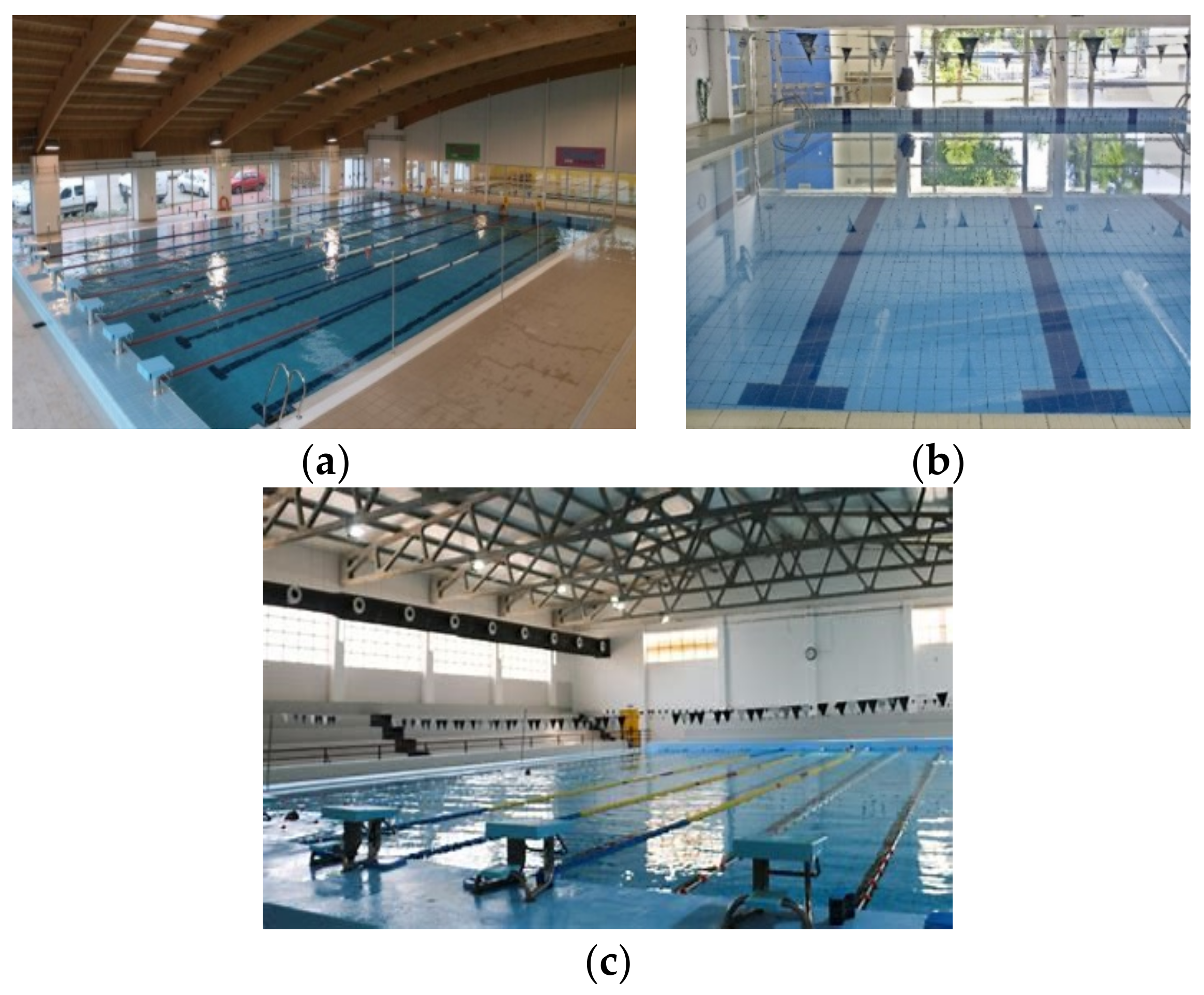
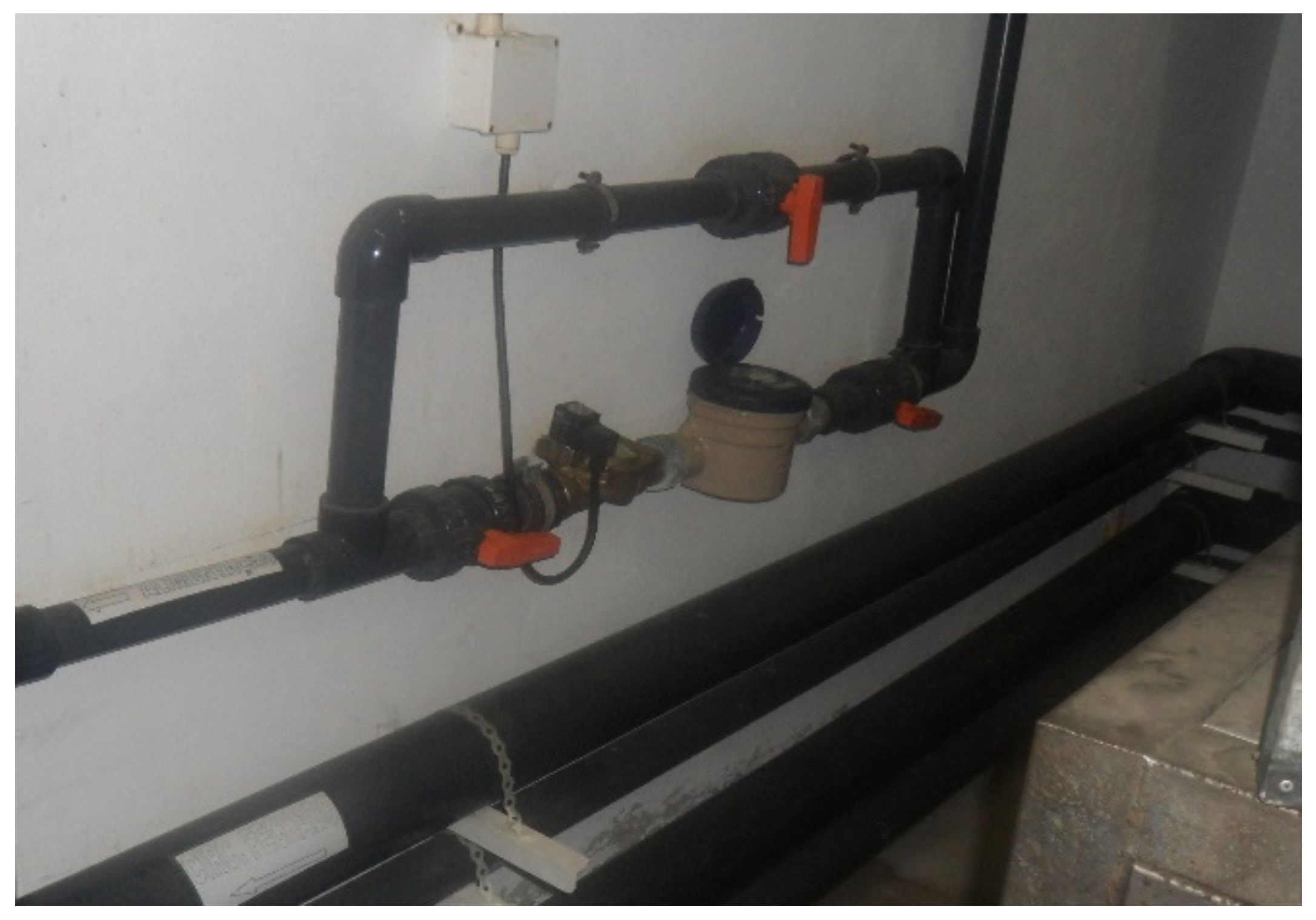
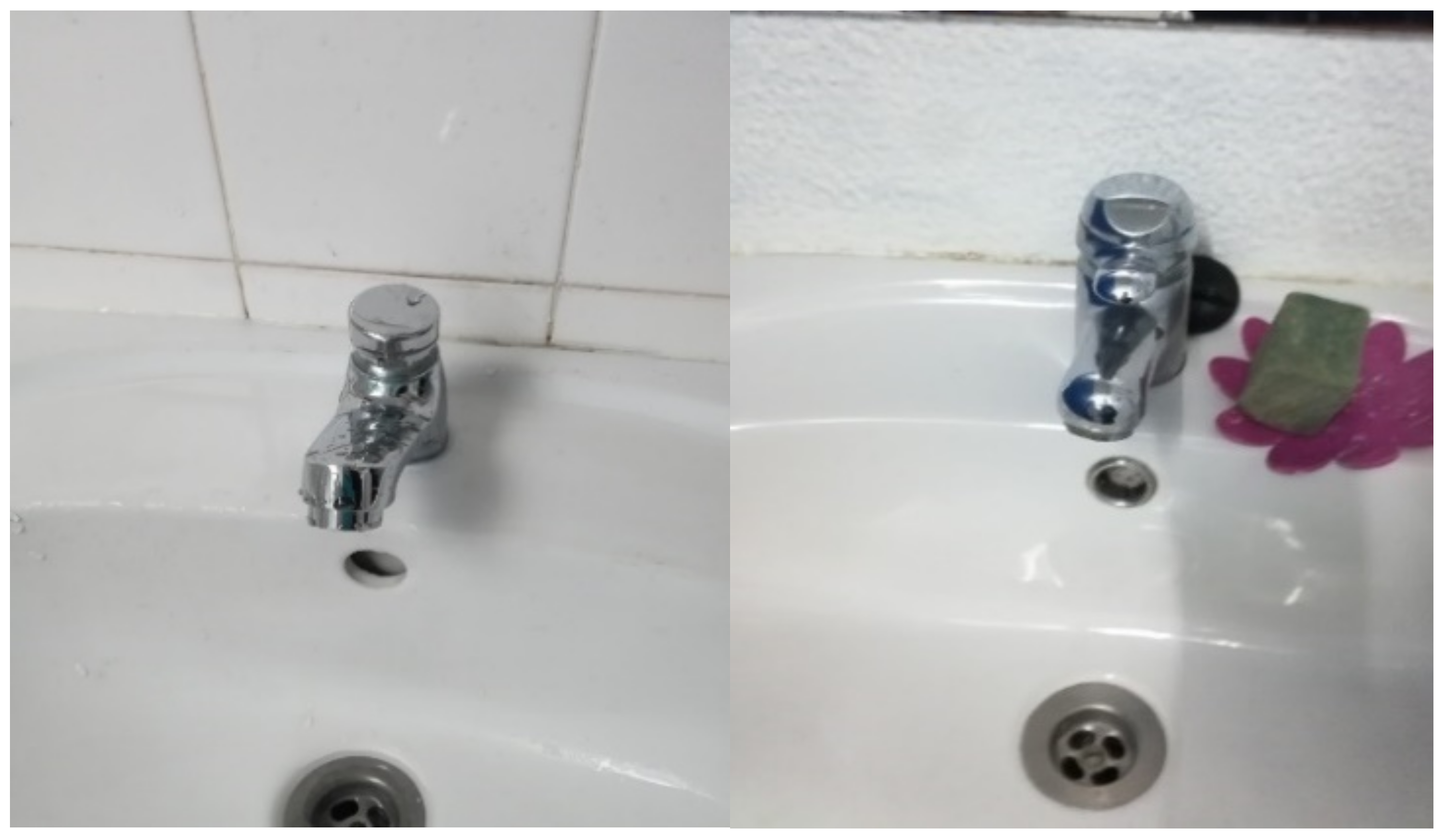

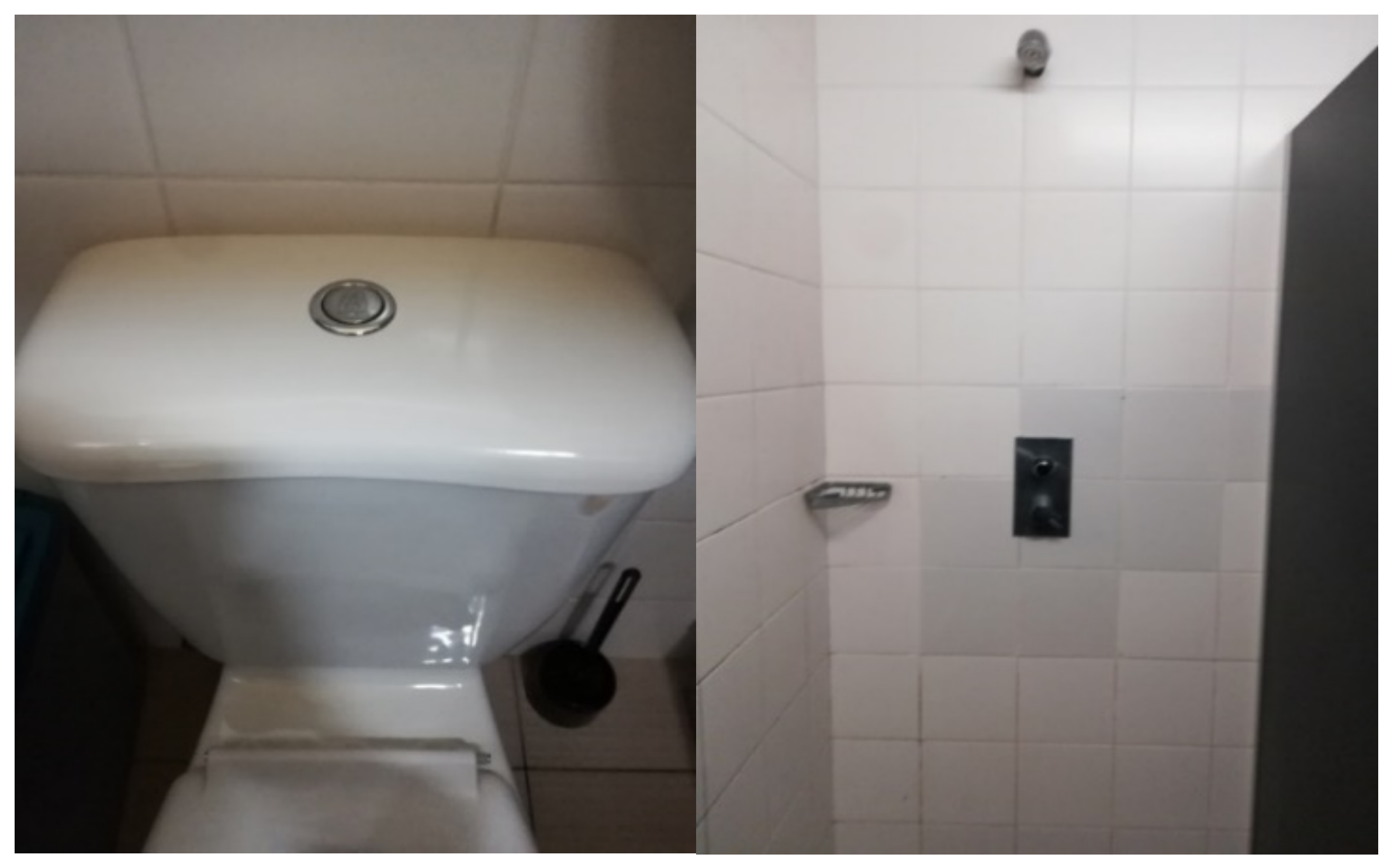
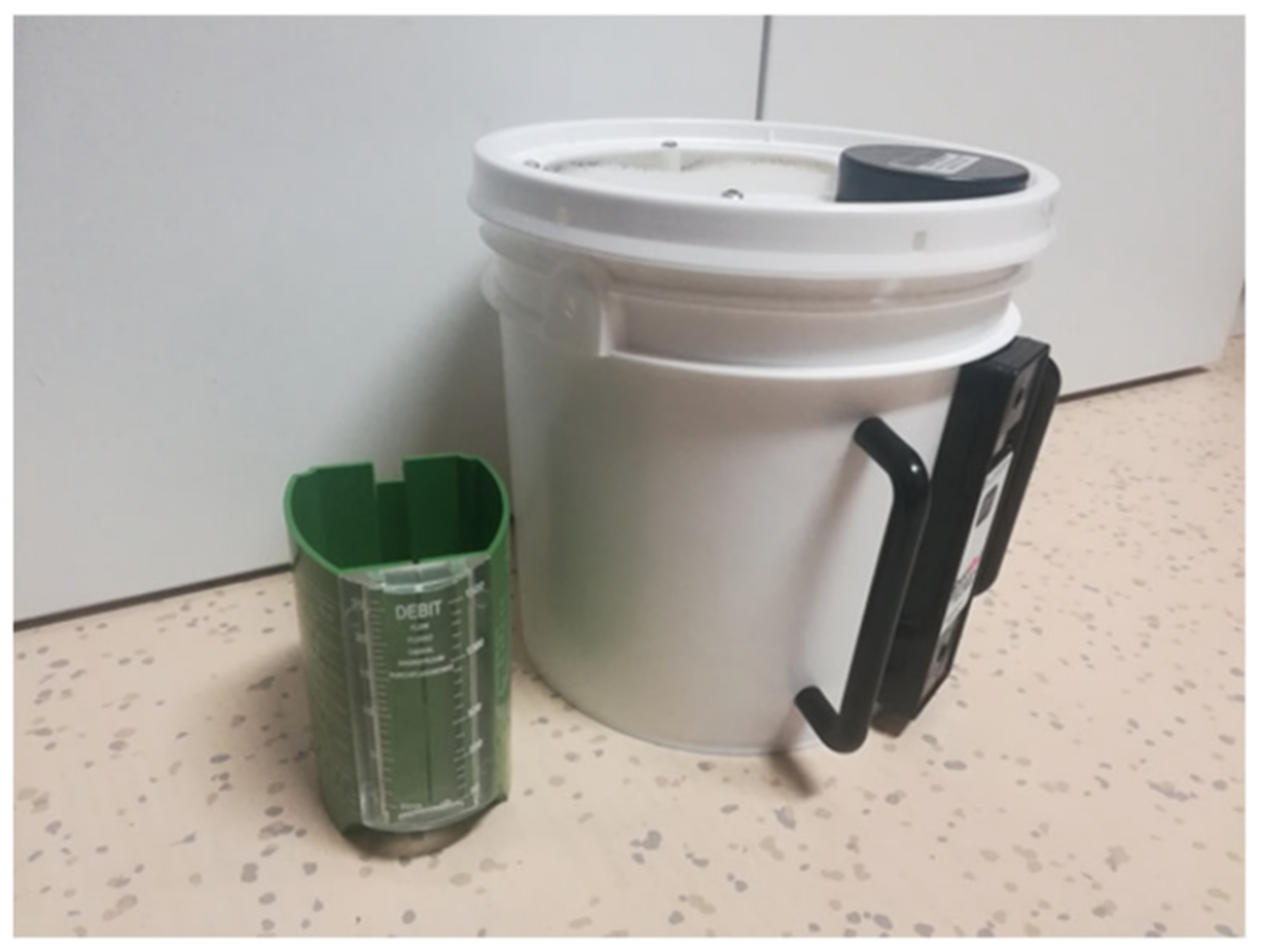
| Characteristics | Swimming Pool | ||
|---|---|---|---|
| Abóboda | Alcabideche | Alapraia | |
| Length (m) | 25.00 | 16.66 | 25.00 |
| Width (m) | 17.00 | 10.00 | 17.00 |
| Maximum depth (m) | 2.00 | 1.40 | 1.65 |
| Minimum depth (m) | 1.80 | 0.90 | 1.30 |
| Total volume (m3) | 808.00 | 184.00 | 600.00 |
| Volume renewed daily (m3) | 16.16 | 3.68 | 12.00 |
| Water percentage renewed daily | 2% | 2% | 2% |
| Characteristics | Swimming Pool | ||
|---|---|---|---|
| Abóboda | Alcabideche | Alapraia | |
| Number of washbasin taps (units) Type of washbasin taps (-) | 38 7 single lever and 31 self-closing | 8 Self-closing | 25 3 single lever and 22 self-closing |
| Average flow rate on taps (L/min) | 7.18 | 6.14 | 6.87 |
| Number of flush toilets (units) | 32 | 9 | 26 |
| Type of flushing cisterns (-) | Single flush | Single flush | 8 dual flush and 18 single flush |
| Average volume (L) | 10.0 | 10.0 | 10.0 |
| Number of showers (units) | 41 | 15 | 33 |
| Type of shower (-) | Fixed shower head, self-closing | Hand-held shower head | Hand-held shower head |
| Average flow rate on showers (L/min) | 8.00 | 14.29 | 12.60 |
| Use | Percentage of Use [21] | Average Annual Consumption (m3) | ||
|---|---|---|---|---|
| Abóboda | Alcabideche | Alapraia | ||
| Toilets (flushing cisterns) | 7.5% | 1789.20 | 604.56 | 712.32 |
| Washbasin taps | 7.5% | 1789.20 | 604.56 | 712.32 |
| Urinals | 1.5% | 357.84 | 120.96 | 142.44 |
| Showers | 41.0% | 9780.96 | 3304.92 | 3893.76 |
| Cleaning and other uses | 13.5% | 3220.56 | 1088.16 | 1282.08 |
| Pool tanks | 29.0% | 6918.24 | 2337.60 | 2754.12 |
| Total | 100% | 23,856.00 | 8060.76 | 9497.04 |
| Swimming Pool | Device | Weighted Average Reduction | Consumption (m3) | ||
|---|---|---|---|---|---|
| Current (Annual) | Reduction (Annual) | Reduction (Monthly) | |||
| Abóbada | Toilets (flushing cisterns) | (10.0 − 4.5)/10.0 = 55.0% | 1789.20 | 984.06 | 82.00 |
| Washbasin taps | (7.2 − 4.0)/7.2 = 44.4% | 1789.20 | 794.40 | 66.20 | |
| Showers | 0% | 9780.96 | 0 | 0 | |
| Alcabideche | Toilets (flushing cisterns) | (10.0 − 4.5)/10.0 = 55.0% | 604.56 | 332.51 | 27.71 |
| Washbasin taps | (6.1 − 4.0)/6.1 = 34.4% | 604.56 | 207.97 | 17.33 | |
| Showers | (14.3 − 8.0)/14.3 = 44.1% | 3304.92 | 1457.47 | 121.46 | |
| Alapraia | Toilets (flushing cisterns) | (18/26) (10.0 − 4.5)/10.0 = 38.1% | 712.32 | 271.39 | 22.62 |
| Washbasin taps | (6.9 − 4.0)/6.9 = 42.0% | 712.32 | 299.17 | 24.93 | |
| Showers | (12.6 − 8.0)/12.6 = 36.5% | 3893.76 | 1421.22 | 118.44 | |
| Parameters | Swimming Pool | |||
|---|---|---|---|---|
| Abóboda | Alcabideche | Alapraia | ||
| Total monthly savings (m3) | (A) | 148.20 | 166.50 | 165.99 |
| Applicable water price (€/m3) | (B) | 1.23 | 2.47 | 1.68 |
| Total monthly savings (€) | (C = A × B) | 182.29 | 411.26 | 278.87 |
| Total investment (€) | (D) | 1020.90 | 455.10 | 1002.45 |
| Current monthly consumption (m3) | (E) | 1988.00 | 671.73 | 791.42 |
| Total savings (%) | (F = A/E) | 7.5 | 24.8 | 21.0 |
| Payback period (months) | (G = D/C) | 5.6 | 1.1 | 3.6 |
| Total annual savings (m3) | (H = 12 × A) | 1778.40 | 1998.00 | 1991.88 |
| Energy used in public networks (kWh/m3) | (I) | 1.98 | 1.98 | 1.98 |
| Annual energy savings (kWh) | (J = H × I) | 3521.23 | 3956.04 | 3943.92 |
| CO2 emissions per kWh (kg/kWh) | (K) | 0.269 | 0.269 | 0.269 |
| Reduction in GHG emissions (kg/year) | (L = J × K) | 972.21 | 1064.17 | 1060.91 |
| Characteristics | Swimming Pool | ||
|---|---|---|---|
| Abóboda | Alcabideche | Alapraia | |
| Volume renewed daily (m3) | 16.16 | 3.68 | 12.00 |
| Water percentage renewed daily | 2% | 2% | 2% |
| Maximum availability possible (m3/day) | (5/7) × 16.6 = 11.54 | (5/7) × 3.68 = 2.63 | (5/7) × 12.00 = 8.57 |
| Maximum availability possible (L/day) | 11,540 | 2630 | 8570 |
| Water needed to flush toilets (m3/year) (from Table 1) | 805.14 | 272.05 | 440.90 |
| Water needed to flush toilets (L/day)(from Table 1) (1) | 2206 | 745 | 1208 |
| Average number of users (users/day) | 494 | 180 | 250 |
| Water needed to flush toilets (L/day) (2) | 494 × 4.5 × 1 = 2223 | 180 × 4.5 × 1 = 810 | 250 × 4.5 × 1 = 1125 |
| Water needed (combining 1 and 2) (L/day) | 2500 | 750 | 1250 |
| Volume adopted for the tanks (L) | 5000 | 1500 | 2500 |
| Parameters | Swimming Pool | |||
|---|---|---|---|---|
| Abóboda | Alcabideche | Alapraia | ||
| Total daily savings (L/day) | (A) | 2206 | 745 | 1208 |
| Total annual savings (m3/year) | (B) | 805.19 | 271.93 | 440.92 |
| Applicable water price (€/m3) | (C) | 1.23 | 2.47 | 1.68 |
| Total annual savings (€) | (D = B × C) | 990.39 | 671.65 | 740.75 |
| Total investment (€) | (E) | 5200.00 | 3800.00 | 4300.00 |
| Payback period (years) | (F = E/D) | 5.3 | 5.7 | 5.8 |
| Parameter | Swimming Pool | Total | ||
|---|---|---|---|---|
| Abóboda | Alcabideche | Alapraia | ||
| Measure 1 | ||||
| Annual water savings (m3) | 1778.40 | 1998.00 | 1991.88 | 5768.28 |
| Annual savings (€) | 2187.48 | 4935.12 | 3346.44 | 10,469.04 |
| Total investment (€) | 1020.90 | 455.10 | 1002.45 | 2478.45 |
| % of water savings (%) | 7.5 | 24.8 | 21.0 | - |
| Medium payback period (years) | - | - | - | 0.24 |
| Annual energy savings (kWh) | 3521.23 | 3956.04 | 3943.92 | 11,421.19 |
| Reduction in GHG emissions (kg/year) | 927.21 | 1064.17 | 1060.91 | 3052.29 |
| Measure 2 | ||||
| Annual water savings (m3) | 805.19 | 271.93 | 440.92 | 1518.04 |
| Annual savings (€) | 990.39 | 671.65 | 740.75 | 2402.79 |
| Total investment (€) | 5200.00 | 3800.00 | 4300.00 | 13,300.00 |
| Medium payback period (years) | - | - | - | 5.53 |
| Measure 1 + Measure 2 | ||||
| Annual water savings (m3) | 2.583.59 | 2269.93 | 2432.80 | 7.286.32 |
| Annual savings (€) | 3.177.87 | 5606.77 | 4087.19 | 10,469.04 |
| Total investment (€) | 1020.90 | 455.10 | 1002.45 | 12,871.83 |
| Medium payback period (years) | - | - | - | 1.23 |
Publisher’s Note: MDPI stays neutral with regard to jurisdictional claims in published maps and institutional affiliations. |
© 2022 by the authors. Licensee MDPI, Basel, Switzerland. This article is an open access article distributed under the terms and conditions of the Creative Commons Attribution (CC BY) license (https://creativecommons.org/licenses/by/4.0/).
Share and Cite
Pimentel-Rodrigues, C.; Silva-Afonso, A. Assessment of Measures to Increase Water Efficiency in Public Swimming Pools. Sustainability 2022, 14, 14726. https://doi.org/10.3390/su142214726
Pimentel-Rodrigues C, Silva-Afonso A. Assessment of Measures to Increase Water Efficiency in Public Swimming Pools. Sustainability. 2022; 14(22):14726. https://doi.org/10.3390/su142214726
Chicago/Turabian StylePimentel-Rodrigues, Carla, and Armando Silva-Afonso. 2022. "Assessment of Measures to Increase Water Efficiency in Public Swimming Pools" Sustainability 14, no. 22: 14726. https://doi.org/10.3390/su142214726
APA StylePimentel-Rodrigues, C., & Silva-Afonso, A. (2022). Assessment of Measures to Increase Water Efficiency in Public Swimming Pools. Sustainability, 14(22), 14726. https://doi.org/10.3390/su142214726







